Invention Patents - for Small Businesses and Inventors
A patent is an exclusive right granted for an invention. Generally speaking, a patent provides the patent owner with the right to decide how - or whether - the invention can be used by others. In exchange for this right, the patent owner makes technical information about the invention publicly available in the published patent document.
Article List
Foreign Patents for Small Business
How Do You Spot a Good Patent?
What Does Patent Pending Mean?
What is a Provisional Patent Application?
Provisionals Part II - Some Things to Be Aware of
How Can You Use Provisionals - Part III
LegalZoom and Invention Submission
Links
So What is a Patent?

US Patent Office definition of patent.
- "A patent for an invention is the grant of a property right to the inventor, issued by the Patent and Trademark Office. The term of a new patent is 20 years from the date on which the application for the patent was filed in the United States or, in special cases, from the date an earlier related application was filed, subject to the payment of maintenance fees. US patent grants are effective only within the US, US territories, and US possessions.
The right conferred by the patent grant is, in the language of the statute and of the grant itself, “the right to exclude others from making, using, offering for sale, or selling” the invention in the United States or “importing” the invention into the United States. What is granted is not the right to make, use, offer for sale, sell or import, but the right to exclude others from making, using, offering for sale, selling or importing the invention."
So a patent is a property right. That idea for that comes all the way back from the original constitution. That right was granted by the U.S. government to an inventor to exclude others from making, using, offering for sale, or selling the invention throughout the U.S. or importing the invention into the U.S.
Included in this definition of patent is the notion of a limited monopoly. For a defined period of time. In return for that right, the inventor must provide a public disclosure of the invention in the form of the issued patent. Although many people view patents as something that impedes the spread of technology the intent is exactly the opposite. The patent has to completely describe the technology to enable others to copy it - after the period of limited monopoly is over. You can see that intent also in the maintenance fee framework of patents, in which the patent owner has to pay an escalating series of maintenance fees over time - which actually encourages inventors to give up the patent to the public unless they are using it.
We will try to supply you with a comprehensive list of useful short articles about invention patents. You can see them on this menu page on patents. The menu will continue to grow over time.
Articles
What is the USPTO definition?
Sometimes, when describing a process it is desirable to show it a a process flow chart. Lets' do that here.
What rights does a patent give you?
Patent Pending
A frequent question we get from some new clients is "How do I get a patent pending? This is another of those frequently misunderstood concepts in patent law.
What is a Provisional Patent Application?
The proper use of a provisional patent application is an important - let's spend a little time on it.
Provisionals - Things to Be Aware of
Some key issues to avoid in using provisionals.
Sometimes there are compelling reasons for small businesses to use provisionals - let's talk about that.
How Do You Spot a Good Patent?
Here are some straightforward things you can look for to evaluate a patent application.
Once you have decided to patent a common question is "When should I file for a patent?"
Foreign Patents for Small Business -I
How do you actually get foreign patents?
Why Should You Do It Before Drafting a Patent Application?
Can I disclose my invention to a large company interested in licensing my invention?
LegalZoom and Invention Submission
Are They Worth It?
What You Need to Know About Inventorship.
Why They Be Crucial.
How Do You Find the Status of a Patent on Application?
What is a Divisional Patent or Application - and What is a Restriction Requirement?
What Does It Mean and What Is It Worth?
How Long Has This Been Going On?
What Do You Really Need to Know?
How Do You Read It?
What Are Its Requirements?
How to Do Them and Read Them.
How Do You Read Patent Claims?
Links
Patents
Return to the Top of This Page
Noltesbip
Return to Home Page
Contact Us
If you have any questions on on this site - please feel free to contact us.